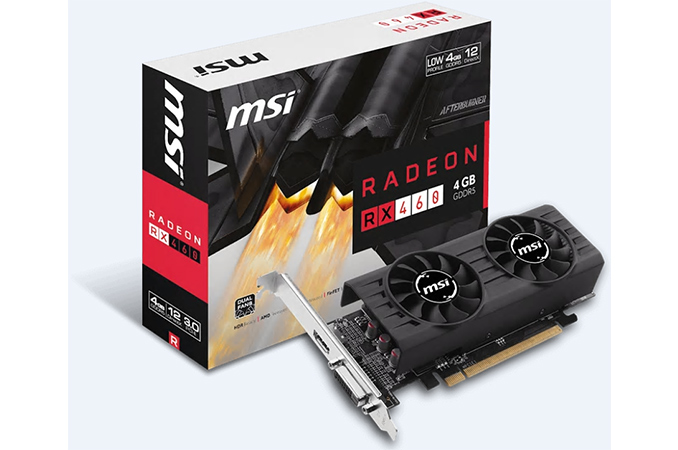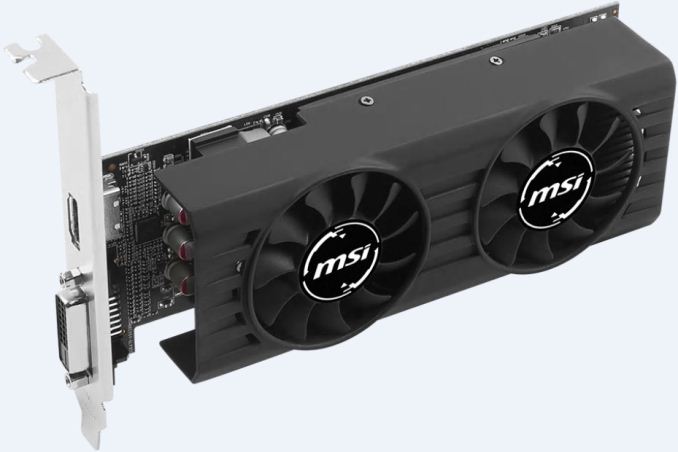MSI Adds Low-Profile AMD Radeon RX 460 Graphics Cards to Lineup
by Anton Shilov on February 18, 2017 1:00 PM EST- Posted in
- GPUs
- AMD
- Radeon
- MSI
- Polaris
- RX 460 4GT LP
- RX 460 2GT LP

MSI has quietly added two low-profile AMD Radeon RX 460 graphics adapters to its product family. The add-in-boards (AIBs) are powered by AMD’s latest entry-level GPU, Polaris 11. As these are base RX 460 models. they do not require PCIe power and are compatible with a wide range of computers that have enough space for a dual-slot card. The new adapters will be among the most affordable discrete graphics options today and will be aimed at those upgrading entry-level systems as well as building SFF HTPCs.
The MSI Radeon RX 460 4GT LP and Radeon RX 460 2GT LP are based on AMD’s Baffin (Polaris 11) graphics chip (896 stream processors, 56 texture units, 16 raster operations pipelines, 128-bit memory bus) clocked at up to 1.2 GHz (base/boost) and carry 2 or 4 GB of GDDR5 memory at 7 Gbps. As for connectivity, the boards have one DL-DVI-D and one HDMI 2.0 output with HDCP 2.2 support (HDCP 2.2 is required for playback of protected UHD video). When it comes to cooling, the AIBs use dual-slot cooling systems with two fans, the same as the company installed on other low-profile graphics cards. As an added bonus, MSI states that it uses MIL-STD-810G certified components to ensure a long lifespan for its LP adapters.
Over the past couple of months, MSI and a number of other companies (GIGABYTE, GALAX) have introduced low-profile graphics adapters based on NVIDIA’s GPUs - MSI is one of the first with similar LP RX 460 cards and extending its range of contemporary LP AIBs to four models. The addition of two low-profile cards to the lineup may indicate that demand for such products is relatively significant and rather stable.
Both AMD Polaris 11 (Baffin) and NVIDIA GP107 GPUs outperform integrated graphics cores of mainstream desktop CPUs and also support modern functionality like DirectX 12 and Vulkan APIs. Furthermore, the two graphics processors support hardware-accelerated decoding and encoding of HEVC (H.265) and VP9 video at 4Kp60 as well as HDR10. Finally, the GPUs consume up to 75 W of power and do not need any auxiliary PCIe power connectors, which makes them compatible with virtually all modern PCs with a PCIe 3.0 x16 slot, including those from various large brands that sometimes do not have any spare connectors left.
| MSI's Radeon RX 460 Low Profile Graphics Cards | ||||||
| RX 460 4GT LP | RX 460 2GT LP | |||||
| GPU | AMD Polaris 11 (Baffin) | |||||
| Stream Processors | 896 | |||||
| Texture Units | 56 | |||||
| ROPs | 16 | |||||
| Core Clock (MHz) | 1090 | |||||
| Boost Clock (MHz) | 1200 | |||||
| Memory | Capacity | 4 GB | 2 GB | |||
| Type | GDDR5 | |||||
| Clock | 7 Gbps | |||||
| Bus Width | 128 bit | |||||
| Outputs | DisplayPort | 0 | ||||
| DVI | 1 × DVI-D | |||||
| HDMI 2.0b | 1 | |||||
| TFLOPS (FP32) | 1.95 | |||||
| TDP | 75 W | |||||
| Launch Date | 2/2017 | 2/2017 | ||||
MSI has not announced MSRPs forthe new cards, and since the AIBs were added to the company’s product family in the last week, they are no yet available at Amazon or Newegg. Given the positioning of the adapters, it is unlikely that their price will be substantially different from $109 (2 GB version) and $139 (4 GB version) recommended by AMD.
Related Reading:















50 Comments
View All Comments
Mobile-Dom - Saturday, February 18, 2017 - link
So close MSI, If only you'd have included DisplayPort instead of DVI, it can be adapted down to nearly everything else, DVI just needs to die alreadyQasar - Saturday, February 18, 2017 - link
dvi needs to die?? you havent noticed that they are STILL putting VGA ports on some NEW monitors ?? i think the industry needs to kill the vga port 1st... then maybe work on the dvi port :-)tulx - Saturday, February 18, 2017 - link
VGA is not going anywhere for a while, though. It's still alive and kicking in the business sector. Almost all customers I visit have projectors with VGA a connection only and that lovely 4:3 aspect ratio. So I'm very glad my Dell E5550 has a VGA port. Otherwise I'd be lugging around around adapters like a Mac user...Kevin G - Saturday, February 18, 2017 - link
The problem with replacing the VGA port for such use-cases isn't the projector or the laptop: both have migrated away (generally to HDMI).The catch is actually cabling as those VGA runs can go around the entire parameter of a room before reaching their destination. If you're lucking, you can use active HDMI copper cabling that can go upward of 75 ft reliability for in-wall installation (they do make 100 ft cables but I wouldn't trust them for that distance). There are active HDMI cables that convert to fiber at each end but those can be flaky as they require a bit of drive power to run the transceivers which not all electronics can provide. A simple powered HDMI switch or distribution amplifier tends to solve the power issue but can invoke the wraith of HDCP. Then there are all the flaws of dealing with fiber on top of ends that cannot be swapped out. HDBaseT is the more ideal solution as it can use Cat5E cabling (though Cat6A shields is preferred for long runs) and a transmitter/receiver pair can be powered together from a single end. The big downside for HDbaseT is that it is expensive with a transmitter/receiver pair starting at $250 per port. Switchers and distribution amplifiers with HDbaseT are also more expensive versus their HDMI-only counter parts. The one area where HDBaseT might save money is in the actual cable run as many venues already have Cat5E cabling going to a projector to handle networking controllers (remote power on etc.). Depending on the venue, it can cost thousands of dollars to install a relatively inexpensive Cat6A cable.
Flunk - Sunday, February 19, 2017 - link
Not true at all, none of the current crop of GPUs supports VGA anymore. This is where VGA dies.Manch - Monday, February 20, 2017 - link
DisplayPort, HDMI, and DVI can all output VGA with a passive adapter. VGA aint dying anytime soon.Death666Angel - Monday, February 20, 2017 - link
Please don't spread fud. If you have DVI-I or DVI-A, you can get an easy analog signal out of it. With HDMI and DisplayPort, you already need an active converter, because they are digital signals only. And the current crop of graphics cards don't offer native analog signals anymore (just Google "analog signal GTX 10 / R9 / Rx480" etc.) The DVI ports are the -D variant. I believe there are only some specialty vendors that add the analog conversion straight to their PCB, but not in the normal gamer focused markets.DanNeely - Monday, February 20, 2017 - link
Interesting. I didn't realize there were specialty makers bundling an active VGA adapter on card. When I saw that none of the gaming OEMs had done so (my old GPUs retired to a KVMed compute cluster, so I was looking for one when I bought my 1080) I'd assumed that AMD and NVidia had drawn a line in the sand and banned including them.Manch - Tuesday, February 21, 2017 - link
My bad, I thought that as long as the card supported it, you didn't need an active adapter. I didn't realize AMD and Nvidia stopped supporting them on their ref designs for consumer cards. I have a few hdmi to vga, and a DP to VGA adapters. I paid a few bucks for each. Didn't think they were active since theyre soo cheap.Pneumothorax - Thursday, February 23, 2017 - link
look closely at the DVI port, it's missing the VGA pins on the bottom. Now look at your DVI/VGA adapters, notice there's pins where the metal 'bar' is at. The lack of the pins means no more cheap passive adapters.